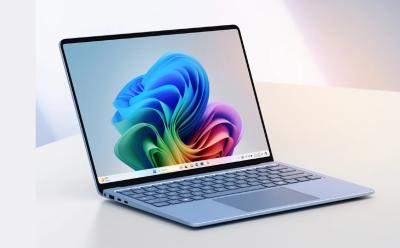The wave of AI-powered Windows 11 laptops dubbed Copilot+ PCs is gaining momentum, with manufacturers deploying Snapdragon X Elite and X Plus chips. Central to these devices is the ARM-based Oryon CPU family, which promises performance that competes with leading desktop-class solutions while prioritizing efficiency. Every Copilot+ PC in the current lineup integrates a Hexagon NPU capable of delivering up to 45 TOPS, underscoring the convergence of AI acceleration and portable computing. In this evolving landscape, several OEMs have rolled out Snapdragon X Elite and X Plus laptops for consumers in 2025, highlighting a trend toward AI-first productivity, creative work, and on-the-go machine learning workloads. Below is an in-depth look at the best Copilot+ PCs featuring Snapdragon X Elite and X Plus processors, with details on specifications, design choices, and what these choices mean for performance, efficiency, and day-to-day use.
Surface Laptop 7th Edition and Surface Pro 11th Edition
Microsoft has introduced two Snapdragon Copilot+ PCs intended for the consumer segment: the Surface Laptop 7th Edition and the Surface Pro 11th Edition. Both devices are powered by a combination of Snapdragon X Elite and Snapdragon X Plus chips, signaling a unified approach to AI-accelerated Windows 11 on ARM devices. The base variant of these machines uses the X1P-64-100 SKU, which identifies a 10-core Oryon CPU configuration. This specific SKU supports a single-core frequency of up to 3.4GHz, illustrating a balance between peak single-threaded performance and broader multi-core efficiency for multi-tasking workloads.
A notable hardware distinction is the Surface Pro’s display feature set: the 120Hz OLED display is available exclusively on the X Elite variant, underscoring the premium nature of that configuration and its suitability for content creation, media consumption, and smooth interactive experiences. Beyond display specs, both Surface devices have undergone a design refresh characterized by notably thinner bezels, a more rounded display, and an improved haptic trackpad. These design updates contribute to improved ergonomics and a more modern aesthetic, aligning with consumer expectations for premium Ultrabook-class devices in the Copilot+ ecosystem.
The Surface Laptop 7th Edition and Surface Pro 11th Edition represent Microsoft’s strategic push to align Windows 11 with Snapdragon X Elite and X Plus silicon, aiming to deliver efficient, AI-accelerated performance in portable form factors. The inclusion of the Hexagon NPU with up to 45 TOPS of compute emphasizes real-time on-device AI acceleration, which can translate to faster on-device inference for features such as natural language processing, image enhancement, and on-device AI workloads that benefit from low-latency processing. In terms of design language and user experience, the changes to bezels, display curvature, and trackpad fidelity are important for daily usage, especially on devices intended for prolonged productivity sessions, video calls, and creative tasks. The lineup illustrates Microsoft’s intent to offer a vivid, energy-efficient Windows 11 experience with Copilot+ hardware optimizations while maintaining a premium chassis and form factor that appeals to both professionals and power users.
In summary, the Surface Laptop 7th Edition and Surface Pro 11th Edition embody a cohesive approach to AI-enabled Windows devices, leveraging the X Elite and X Plus families, a high-core-count Oryon CPU, and a capable Hexagon NPU to deliver balanced performance, battery life, and AI-assisted workflows. The combination of a 10-core Oryon CPU with up to 3.4GHz single-core turbo, the 120Hz OLED option on the Pro’s X Elite variant, and refined industrial design demonstrates a strong commitment to blending productivity, creativity, and AI efficiency in a seamless Windows 11 experience. As these devices gain traction, users can anticipate a broader ecosystem of Copilot+ software optimizations, better on-device AI acceleration, and ongoing improvements in display quality, input devices, and overall system responsiveness—particularly for AI-driven tasks and real-time inference workloads.
Asus Vivobook S 15
The Asus Vivobook S 15 emerges as the most value-oriented Snapdragon X Plus laptop currently available, making a compelling case for buyers who want meaningful AI acceleration without paying a premium for flagship hardware. The Vivobook S 15 features the X1P-42-100 SKU, a configuration that delivers a maximum single-core frequency of up to 3.4GHz. This choice positions the device well for everyday productivity tasks, such as document processing, web browsing, and multimedia consumption, while still offering the benefits of a multi-core Oryon CPU for more demanding workloads that leverage parallel processing.
A standout feature in this model is the inclusion of a 3K OLED display, which provides rich color accuracy, deep blacks, and a visually engaging experience for media consumption, photo editing, and creative tasks that can benefit from high pixel density and vibrant color reproduction. The Vivobook S 15 has been positioned at an accessible price point, with a price tag around $549 in the current market, which enhances its appeal for budget-conscious consumers who still demand capable AI-enabled performance. The combination of an 8-core Oryon CPU with the X Plus family’s AI acceleration, alongside a robust display, makes this device an attractive option for students, freelancers, and general consumers who require competent machine-learning capabilities on a portable platform.
From a value perspective, the Asus Vivobook S 15 represents a compelling entry point into the Copilot+ ecosystem. The configuration choices—X1P-42-100, 3.4GHz single-core performance, and a 3K OLED display—provide a balanced mix of core performance, AI-ready acceleration, and visual quality. For users who primarily rely on cloud-based AI services, the integrated Hexagon NPU still adds on-device inference capability, supporting tasks like real-time transcription, on-device image enhancement, and other AI-powered enhancements without always routing data to the cloud. The device’s affordability, combined with a reasonable AI-focused CPU cluster, makes it a practical option for those who want to experiment with on-device AI workloads while maintaining everyday usability. As more Snapdragon X Elite and X Plus configurations enter the market, the Vivobook S 15 offers a compelling baseline to compare performance, energy efficiency, and display quality across the Copilot+ laptop lineup.
In short, the Asus Vivobook S 15 represents the strongest value proposition among current Snapdragon X Plus laptops, delivering solid performance through the X1P-42-100 SKU, a 3.4GHz single-core cap, and a premium 3K OLED screen at an accessible price. The combination of affordability, a capable Oryon CPU core count, and the benefits of an on-device Hexagon NPU makes it an attractive option for users prioritizing cost efficiency without sacrificing AI-ready performance and display quality. The model stands as a practical entry point into Copilot+ PC experiences for students, remote workers, and everyday users who want improved AI acceleration without a high premium.
Dell XPS 13
Dell’s XPS 13 lineup expands with a Snapdragon X Elite-powered variant that is described as the second-most powerful option within the X Elite family. The Dell XPS 13 is equipped with the X1E-80-100 SKU, which positions it as a premium offering within the X Elite tier. The X1E-80-100 configuration emphasizes high-end performance and efficiency, aligning with Dell’s tradition of premium build quality and display excellence.
The XPS 13’s display is a highlight, featuring an OLED touchscreen InfinityEdge panel that delivers striking contrast, vivid color reproduction, and immersive visuals for multimedia consumption, content creation, and productivity tasks. The display’s privacy, durability, and brightness levels complement the device’s premium chassis, which is crafted from machined aluminum and finished to a refined standard. The protective Gorilla Glass 3 coating on the display adds durability and scratch resistance, helping sustain a premium look and feel through regular daily use.
From a design and build perspective, the XPS 13 continues Dell’s long-standing emphasis on premium materials, precise tolerances, and a sleek, modern aesthetic. The combination of a high-quality OLED panel, a robust chassis, and Snapdragon X Elite processing creates a compelling package for power users who demand high display quality, robust AI acceleration, and efficient performance for Windows 11 Copilot+ workflows. The device’s CPU/GPU/AI balance, together with the Hexagon NPU’s up-to-45 TOPS AI inference capability, offers strong on-device AI performance for tasks like real-time language translation, image processing, and on-device ML workloads, complementing cloud-based AI services.
In terms of value, the XPS 13 with the X Elite configuration is positioned as a premium portable workstation that can handle demanding tasks such as software development, data analysis, design work, and AI-assisted productivity. The OLED display enhances user immersion and reduces fatigue during extended sessions, while the aluminum chassis provides rigidity and a premium tactile experience. The X1E-80-100 SKU’s multi-core performance, coupled with the on-device AI acceleration, makes it a strong option for professionals who require a compact, yet powerful machine capable of running Windows 11 Copilot+ features with responsiveness and energy efficiency.
Dell’s approach with the XPS 13 demonstrates how premium OEMs are leveraging Snapdragon X Elite to deliver top-tier performance in ultracompact form factors. The device is designed for users who want a high-quality display, refined chassis construction, and AI-powered capabilities on the go. It serves as a strong counterpoint to the consumer-focused options, offering a blend of luxury, performance, and AI readiness that suits professionals and enthusiasts who prioritize a premium, portable Windows 11 experience.
Lenovo Yoga Slim 7x
Lenovo has expanded its Snapdragon edition lineup with five Copilot+ laptops, with the Yoga Slim 7x standing out as the premier Snapdragon X Elite option within the family. The Yoga Slim 7x is powered by the X1E-78-100 SKU, which represents the third chipset in the X Elite lineup and is designed to deliver a broad spectrum of performance and efficiency benefits for on-the-go users. The device ships with 12 Oryon CPU cores, a configuration that emphasizes concurrent multi-threaded workloads, parallel processing, and the ability to scale across heavy multitasking scenarios. A notable note from Lenovo is that, despite the higher core count, there is no dual-core boost on any of the cores, indicating a design choice focused on sustained multi-core performance rather than short bursts of single-threaded speed.
The Yoga Slim 7x’s Snapdragon edition approach reflects Lenovo’s strategy to offer a balanced mix of performance, portability, and AI capability in a premium chassis. The 12-core Oryon CPU enables efficient handling of complex workloads, including AI inference, data processing, content creation, and software development tasks, while the Hexagon NPU provides dedicated AI acceleration for on-device tasks. This combination helps deliver smoother, more responsive experiences when running Windows 11 Copilot+ features, which can include on-device AI enhancements, real-time suggestions, and improved efficiency for AI-based workflows.
Lenovo’s emphasis on a robust core count without dual-core boosts suggests a focus on multi-threaded performance, which is beneficial for workloads such as large document editing, virtualization-lite scenarios, code compilation, and media processing. The Yoga Slim 7x’s design philosophy likely centers on delivering a premium, compact laptop with strong performance characteristics and a comfortable user experience for prolonged computing sessions. By positioning the Yoga Slim 7x as the best Snapdragon X Elite laptop in Lenovo’s lineup, the company signals its intent to offer a high-end, AI-augmented alternative to the broader market.
In practice, users who require a reliable, capable, and AI-friendly Windows 11 experience on the go—whether for productivity, creative tasks, or software development—will find the Yoga Slim 7x appealing. The combination of a 12-core Oryon CPU, a capable X Elite configuration, and on-device AI acceleration via the Hexagon NPU makes it a compelling choice for professionals who demand performance consistency, efficient power usage, and rich AI features in a portable package. The device’s design, cooling, and keyboard comfort will also play a role in long daily usage, and Lenovo’s engineering choices are aligned with delivering a cohesive, multi-use laptop that thrives in both productivity-oriented and AI-enhanced workflows.
Samsung Galaxy Book4 Edge
Samsung has introduced the Galaxy Book4 Edge as the flagship member of its Snapdragon X Elite lineup, bringing the most powerful variant in the X Elite stack to the Book4 Edge. The device is equipped with the X1E-84-100 processor, the top-of-the-line configuration within the X Elite family, which is designed to handle the most demanding AI workloads and performance requirements in a thin-and-light chassis. Reports indicate that this top-end processor consumes around 80W, reflecting the substantial processing capabilities and the heat and energy management considerations that come with high-performance configurations in premium ultrabooks.
For users seeking maximum single-core speed and multi-core throughput, the Book4 Edge delivers a notable uplift with a dual-core boost that can reach up to 4.2GHz on the top-end variant. This level of clock speed supports faster peak performance in single-threaded tasks, which can be beneficial for certain applications such as software development environments, certain creative software tools, and real-time editing workflows. The device also has a base configuration that starts with the X1P-42-100 SKU, which aligns with 8 Oryon CPU cores, offering a more affordable option that still provides strong on-device AI acceleration and general performance.
The Galaxy Book4 Edge ships with 16GB of RAM and up to 512GB of eUFS storage, which ensures fast data access and efficient multitasking. The combination of the high-end X Elite processor, ample memory, and fast storage makes the Book4 Edge a compelling option for professionals and power users who require responsive AI-enabled performance, smooth multitasking, and robust media handling capabilities in a portable form factor. Samsung’s execution in this model emphasizes premium build quality, display performance, and the ability to sustain AI workloads with on-device inference, enabling quicker responses for on-the-go AI tasks, including language processing, image and video processing, and other Copilot+ features that benefit from low-latency processing on-device.
In the broader context, the Galaxy Book4 Edge represents Samsung’s commitment to delivering the most capable Copilot+ device within its lineup, combining the highest-end X Elite silicon with a premium display, design, and feature set. The combination of the top-tier CPU, ample RAM, and fast storage, aligned with the Hexagon NPU’s up-to-45 TOPS on-device AI inference, makes the Book4 Edge a strong option for users who demand top-tier AI performance in a sleek, portable package.
HP OmniBook X 14
HP presents the OmniBook X 14 as its next-generation Copilot+ PC offering, powered by Qualcomm’s Copilot+ PC chipset. In the base configuration, the HP OmniBook X 14 is equipped with the Snapdragon X Plus processor, identified by the X1P-42-100 SKU. This arrangement signals a strong emphasis on portability, efficiency, and AI-friendly performance suitable for everyday productivity tasks, light content creation, and on-device AI workloads that benefit from the Hexagon NPU.
As an ultrabook-focused design, the OmniBook X 14 emphasizes thin and light form factors, aligning with user expectations for long battery life, comfortable keyboards, and a seamless Windows 11 Copilot+ experience. HP asserts that the Copilot+ PC offers a long battery life, claiming up to 26 hours of continuous usage on a single charge under typical workloads. This battery life claim positions the device as a practical option for professionals and students who require reliable endurance for travel, meetings, and extended work sessions away from power outlets.
From a hardware perspective, the base X Plus configuration supports AI acceleration and on-device processing while maintaining the energy efficiency needed for a portable device. The OmniBook X 14’s combination of moderate CPU performance, Hexagon NPU AI acceleration, and a focus on battery life makes it a strong choice for users who want a reliable Windows 11 Copilot+ experience with long endurance and a lightweight chassis. In practice, this device targets users who prioritize portability, battery longevity, and AI-enabled productivity, such as students, field professionals, and remote workers who rely on AI features to augment everyday tasks without needing high sustained CPU turbo performance.
Acer Swift 14 AI
Acer marks its entry into the Copilot+ era with the Swift 14 AI, the first Snapdragon X Elite laptop in the Swift lineup. The device comes in multiple models that integrate the third variant of the X Elite chipset, the X1E-78-100, alongside Snapdragon X Plus variants (X1P-64-100). The X Elite SKU here offers 12 CPU cores yet does not provide a dual-core boost on any cores, underscoring a design philosophy that prioritizes multi-core efficiency over short bursts of single-threaded speed. Clock speeds reach up to 3.4GHz for the relevant cores, offering robust multi-threaded performance suitable for AI workloads and demanding productivity tasks.
The X Plus configuration in the Swift 14 AI features 10 CPU cores clocked at 3.4GHz, delivering a slightly different performance envelope that emphasizes responsiveness and efficiency for everyday tasks and light AI workloads. Acer’s Swift 14 AI places emphasis on delivering a compact, portable, and capable machine that can handle on-device AI acceleration via the Hexagon NPU while offering a premium display and build quality typical of the Swift series. The Swift 14 AI’s positioning as a first-mover in Swift for Snapdragon X Elite reflects Acer’s strategy to bring AI-enabled Windows devices into mainstream markets, making Copilot+ features accessible to a broader audience.
The Swift 14 AI’s combination of a 12-core X Elite CPU core set and an X Plus option creates a versatile platform for users who require AI acceleration for tasks such as real-time image processing, on-device transcription, or AI-assisted content creation, all while maintaining everyday usability for web browsing, document editing, and media consumption. The device’s design focuses on a light chassis, comfortable keyboard, and a display that complements the on-device AI experience. The Swift 14 AI stands as Acer’s statement that Copilot+ AI-ready laptops can be integrated into mainstream product lines without compromising portability or affordability. It gives users another compelling option in the Snapdragon X Elite ecosystem, broadening the reach of AI-enabled Windows devices for various use cases, including education, business, and personal productivity.
Honor MagicBook Art 14 Snapdragon
Honor, once a sub-brand of Huawei and now operating independently, introduces the MagicBook Art 14 Snapdragon as part of its Copilot+ portfolio. This model features the X Elite processor in the X1E-80-100 configuration, positioning it among the higher-end X Elite options within Honor’s lineup. The device emphasizes a premium OLED screen, delivering vivid color accuracy and high contrast necessary for creative work, media consumption, and professional tasks that benefit from a rich, accurate display. Honor’s approach highlights a focus on design, display quality, and AI-ready performance in a portable package.
One notable regional limitation for this model is its availability in the United States, as it is not currently offered there. Instead, EU users can purchase the MagicBook Art 14 Snapdragon for about €1,699, reflecting a strategy that prioritizes certain markets for specific Copilot+ configurations. The device also includes a substantial memory configuration with 32GB of onboard memory, enabling robust multitasking and efficient on-device AI workloads. The MagicBook Art 14 Snapdragon aligns with Honor’s emphasis on design aesthetics, display quality, and practical AI acceleration, offering a compelling option for users who prioritize a premium OLED experience and AI-ready performance in a portable form factor.
So these are the current top Copilot+ PCs across multiple OEMs that have launched laptops utilizing Snapdragon X Elite and X Plus processors. Collectively, these machines illustrate how OEMs are embracing AI acceleration directly on devices, with the Hexagon NPU providing up to 45 TOPS of on-device AI inference, and the Oryon-based CPUs delivering a blend of performance and efficiency across different core counts and clock speeds. As more manufacturers introduce Snapdragon-edition laptops, the lineup is likely to expand with additional SKUs, configurations, and design philosophies that balance AI capabilities with everyday usability. This evolving ecosystem underscores a broader shift toward on-device AI acceleration, deeper Windows 11 Copilot+ integration, and a broader range of form factors designed to meet diverse user needs, from productivity and creativity to on-the-go AI-enabled workflows.
Conclusion
The Copilot+ PC family, driven by Snapdragon X Elite and X Plus processors paired with Oryon CPUs and Hexagon NPUs, marks a significant shift in how Windows laptops approach AI acceleration, performance, and efficiency. Across Surface, Asus, Dell, Lenovo, Samsung, HP, Acer, and Honor devices, the emphasis is on delivering powerful on-device AI inference, sustained multi-core performance, high-quality displays, and thoughtful design choices that enhance daily computing. The presence of up to 45 TOPS of AI inference, a range of core counts from 8 to 12 Oryon cores, and multiple configurations within each product line demonstrates a commitment to giving users flexible, high-performing options that can handle AI-assisted tasks, content creation, and everyday productivity in a portable format.
As the Copilot+ ecosystem continues to mature, expect ongoing optimizations for Windows 11 on ARM, better real-time AI features that leverage on-device processing, and further specialization of devices to target specific use cases—whether for professionals demanding premium displays and build quality, students seeking long battery life, or creators requiring substantial AI acceleration in a compact chassis. OEMs are likely to expand their Snapdragon-based offerings with additional SKUs, refinements to cooling and power management, and refined software integrations that maximize the benefits of the Hexagon NPU and the Oryon CPU’s performance and efficiency. For consumers, this translates into a growing set of choices that combine AI-ready performance, on-device inference, and portable form factors suitable for a modern Windows 11 Copilot+ workflow.



